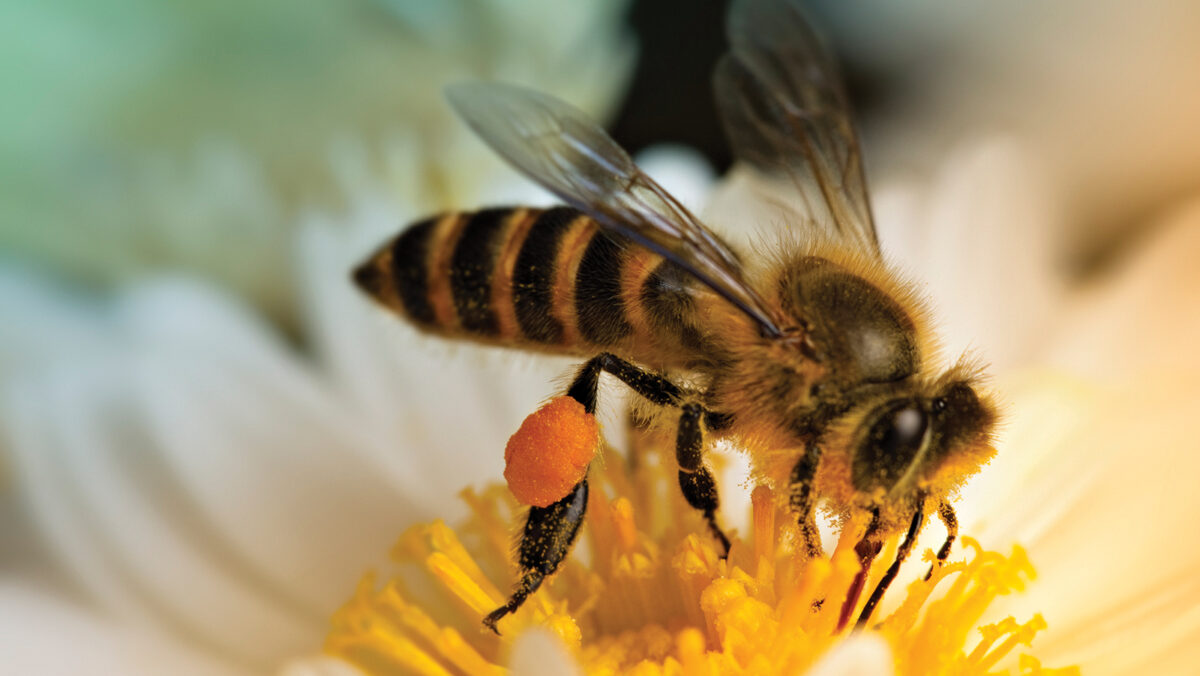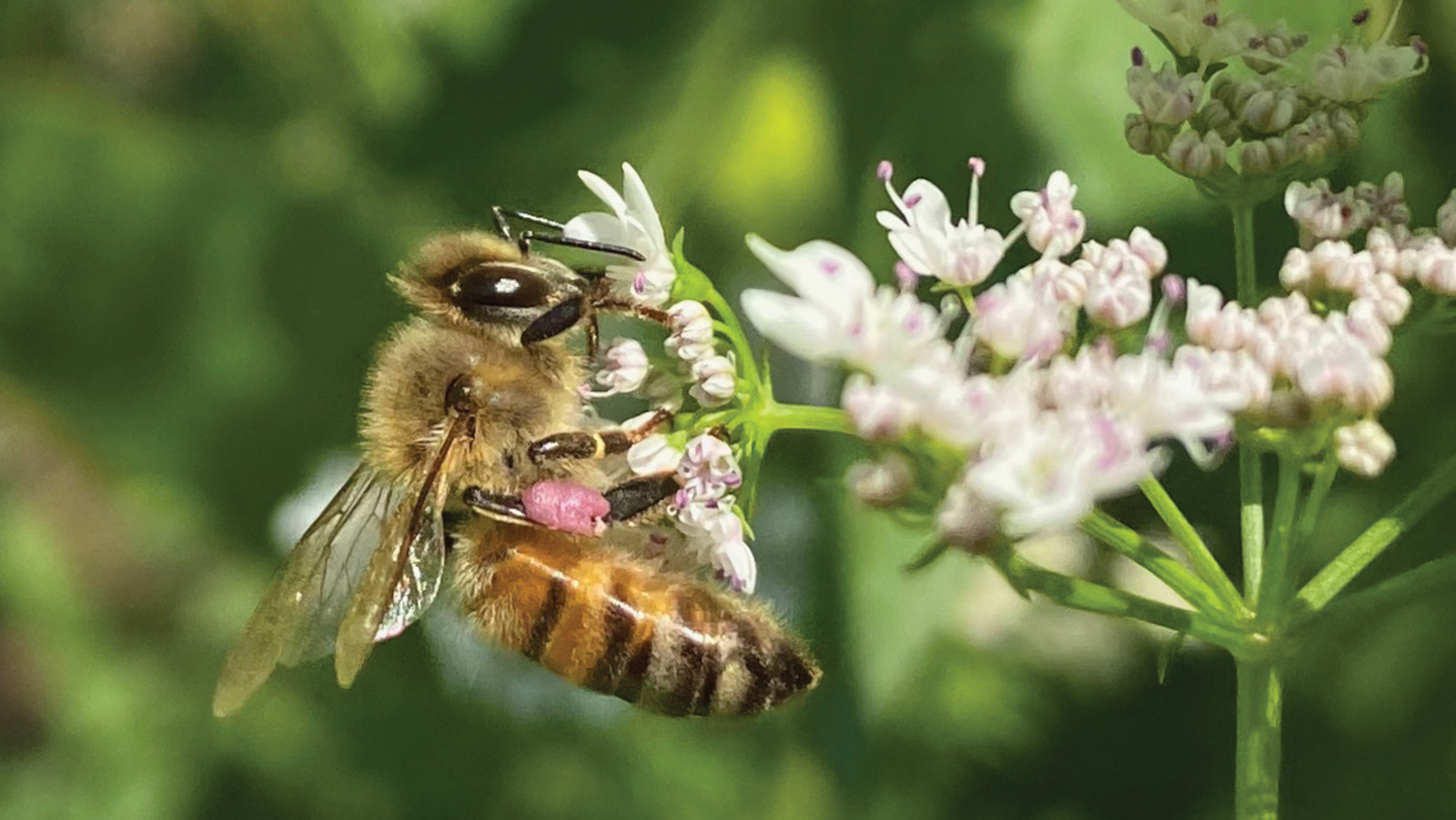
Is It Time to Revive the Colorado Bee and Bee Products Act?
September/October 2025
Download This Article (.pdf)
As I See It is a forum for expression of ideas on the law, the legal profession, and the administration of justice. The statements and opinions expressed are those of the authors, and no endorsement of these views by the CBA should be inferred.
The worldwide decline in the numbers and health of honeybees is a frequent topic in the news, and “save the bees” has become a popular cause. Challenges posed by pesticides, poor nutrition, and loss of habitat are well known but pale in comparison to a new parasitic threat on the horizon. Colorado has very little means to monitor or control for this new threat because the sole legislation aimed at controlling the spread of bee diseases, the Colorado Bee and Bee Products Act (Colorado Bee Act), was defunded in 1990.
This has left us increasingly vulnerable to honeybee diseases and parasites in the decades since—and the problem is only getting worse. In fact, continuing a trend that started in 2006 with the onset of “Colony Collapse Disorder,”1 catastrophic losses of honeybee colonies continue to plague the United States, with beekeepers across the nation reporting an average loss of 68% of their colonies over the past year.2 This should sound the alarm because honeybees are the backbone of the food ecosystem, and extraordinary losses of honeybee colonies nationwide would ravage our food supply.3
Given the severity and immediacy of the issue, the time has come to revive the Colorado Bee Act and the position of state apiary inspector within the Colorado Department of Agriculture. The Colorado Bee Act, codified at CRS § 35-25-105, was enacted in 1963 to ensure the health of bee populations across the state, primarily by enlisting a state apiary inspector to examine beehives for disease. But nearly 30 years later, the Colorado General Assembly determined that programs like it must be “self-funded.” When the Colorado beekeeping community was asked to provide that funding on its own in 1990, and asked again a decade ago, they declined. Given that honeybee health is critical to Colorado’s agricultural economy and our food supply, beekeepers should not be expected to foot the bill on their own. It is time for the Colorado General Assembly to find a way to reestablish this small but critical program. If we continue to ignore the issue, the consequences could be catastrophic.
Honeybees Are Vital to Our Economy
Managed honeybees are vital laborers in Colorado’s economy: they pollinate more than one-third of our food supply and account for at least $15 billion in crop production per year nationwide.4 Producers of Colorado’s peaches, cherries, and apples, as well as squash, alfalfa, and melons, depend on these tiny creatures for pollination each spring.5 A small number of large-scale commercial beekeepers around the state provide most of these pollination services, but over the past 10 years there has also been an explosion in “backyard” or hobbyist beekeeping. There are approximately 3,000 beekeepers in the Colorado State Beekeepers Association, and there are 20 local “bee clubs” in the state.6 In 2023, Colorado beekeepers produced over one million pounds of honey, with a wholesale value of $3.7 million.7

Ongoing and Future Threats to Honeybee Health
Threats to honeybees are not new. Introduction of a bee parasite called Varroa destructor in 1987 is widely believed to be a major factor in the current challenges to the health of honeybee colonies, along with exposure to pesticides and poor nutrition due to an unvaried agricultural landscape. Varroa weakens a honeybee colony by vectoring numerous viruses and feeding on both larvae and adults. It has become the scourge of beekeeping worldwide, and most beehive management today revolves around controlling these destructive mites. Once they arrive in an area, controlling their spread is virtually impossible.8
North American beekeepers now face an even bigger threat from another parasitic mite, the Tropilaelaps mercedesae (Tropi m.).9 If unchecked, this tiny mite will kill a honeybee colony within 30 days and spread well beyond the apiary. Tropi m.’s home turf is Asia, where it originally infested the giant honeybee species Apis dorsata. At some point in the recent past, it jumped species and started to infest Apis mellifera (or Western honeybee), the honeybee species kept in managed hives throughout most of the world, including Colorado. When Tropi m. enters a country where the Western honeybee is the dominant species, hive losses increase exponentially. This mite is harder to detect and moves faster within a hive than Varroa. So far Tropi m. has not reached US shores, but beekeepers believe it is only a matter of time until this happens.
Honeybees and other insects often stow away in cargo containers and arrive uninvited well beyond their home territories. A notorious example is the 2019 discovery of the Northern Giant Hornet on Vancouver Island, which set off a media frenzy of stories about the “murder hornet.” This 2.2-inch-long wasp arrived unnoticed via container ships from East Asia.10 It is likely that Tropi m. will arrive in a similar way, probably in a cargo container with a stray swarm of honeybees inside. Because it is seen as an inevitable invasion, North American beekeepers, apiary inspectors, and researchers are desperately trying to learn as much as they can about Tropi m. and discover how to control it before it arrives. One of the premier researchers in the field, Dr. Sammy Ramsey of the University of Colorado–Boulder, has said that “the possibility that Tropilaelaps could take over is quite substantial.”11 Dr. Ramsey has led research into learning as much about this mite as possible before that happens.
With No Statewide Monitoring of Honeybee Health, Our Apiaries Are Vulnerable
Most states, including many of Colorado’s neighbors, have a state apiary inspector program within a regulatory scheme to control and manage honeybee disease through various inspection programs, registration of hive locations, education, and authority to isolate or order destruction of diseased colonies;12 many states also have statutes and regulations controlling the transport of honeybee colonies across their borders.13 The now-unenforced Colorado Bee Act provided for a state apiary inspector as well as monitoring and control of bee diseases. It empowered the commissioner of agriculture, through a state apiary inspector, to examine apiaries suspected to be infected or diseased and order treatment.14 It required that honeybees be kept in hives with moveable combs, which allow easy inspection.15 It required a permit to import bees into the state and required a certificate of health from their state of origin. It gave the apiary inspector the power to quarantine apiaries and take the steps necessary to control any hazard or disease.16
Enforcement of the Colorado Bee Act was assigned to the Colorado Department of Agriculture and funded with general funds. The commissioner of agriculture established regulations and employed a state apiary inspector. However, in the mid-1980s the Colorado General Assembly decided that this and other programs must be “self-funded.”17 The beekeeping community at the time was quite small and could not fund this program on its own through fees, so it was discontinued in 1990.18 From 2014 to 2017, the commissioner reached out to the state’s beekeepers to determine whether the program could be revived, but the majority of the beekeeping community at the time did not feel it was economically possible for them to be the sole funders of a regulatory program, and were against regulation in general.19 No further efforts have been made to reestablish the program.
The only enforced regulation of beekeeping in Colorado now occurs via city and county ordinances, and some homeowner associations’ bylaws, which contain a variety of basic rules about where and how honeybees can be kept within their borders.20 However, these ordinances do not include any means of monitoring or containing disease or bee parasites. Because honeybees can travel up to five miles from their hive to obtain needed resources and do not respect our political boundaries, a patchwork of local regulation does not provide an effective substitute for a systematic state program with enforcement by an authorized apiary inspector.
Not only is there no state or local control over the spread of honeybee parasites and diseases, but the US government does not provide any such service either. Although the US Department of Agriculture (USDA) currently employs a state “apiary specialist” in Colorado to perform some limited voluntary testing for virus and disease in large apiaries within the state, this specialist is employed seasonally on a part-time basis and has no authority to recommend treatment, do regular monitoring, or quarantine any problematic colonies. Recent federal funding freezes further jeopardize even this modest level of monitoring and data collection.21
During the spring pollination season, millions of out-of-state honeybee colonies travel Colorado’s highways in truckloads of up to 400 colonies each to reach fruit and nut orchards in California, Arizona, and the Pacific Northwest.22 This movement is completely unregulated and unmonitored by Colorado. Colorado’s honeybees, and the agricultural industries that depend on them, are therefore vulnerable to whatever pests or disease might escape from these hundreds of semi-trucks carrying honeybees.
As the law stands now, shipments of out-of-state bees, which could potentially carry Tropi m., are free to cross Colorado on their way to pollinate crops in other states without any inspection or monitoring; the explosion in hobbyist beekeepers has brought in thousands of new beekeepers who may not be able to recognize or manage Tropi m. if it infests their hives. And honeybees are routinely imported into the state to repopulate bee yards decimated by the past year’s losses without any required certification of their health. The uncontrolled spread of Tropi m. and the viruses it vectors to managed beehives will cause uncountable losses to Colorado’s already challenged beekeeping community as a whole and the agriculture industry that depends on it. Failure to address this problem could have a devastating impact on both food prices and Colorado’s economy.
The Time Has Come to Revive the Colorado Bee Act
With ongoing huge yearly losses of the nation’s honeybee colonies, and the specter of an even more devastating pest on the horizon (Tropi m.), the time has come to revisit the issue of funding and reestablishing Colorado’s apiary inspector program. The Colorado beekeeping community has held its own against the Varroa mite through education and self-monitoring, but it is doubtful that this informal system could withstand the onslaught of a catastrophic Tropi m. infestation. Because there is presently no enforced regulatory system in place in Colorado to monitor and control bee diseases and pests, Colorado’s honeybees, and the agriculture industry that depends on them, are at grave risk.
After the discussions about reviving the act were held in 2014–17, the commissioner of agriculture left open the possibility of restoring it in the future if a funding mechanism could be established.23 In the decade since these discussions, beekeepers have faced increasing economic challenges and now face an existential biological threat from Tropi. m.24 The current economics of beekeeping mean that beekeepers have even less ability to fund their own inspection program than they did in either 1990 or in 2014–17. And, given their importance to the security of our food supply, they should not be asked to do so alone. The burden of funding such a program should be shared by the state as a whole.
After more than 30 years with no state oversight, the Colorado beekeeping community may be reluctant to resubmit to the authority of a state apiary inspector. Although some older commercial beekeepers are thankful that they no longer need to deal with an apiary inspector, some newer beekeepers would welcome one, knowing that statewide monitoring would give their own colonies some protection from surrounding apiaries with disease or pests. The threat of Tropi m. has revived these discussions within the beekeeping community. Beekeeping is a marginally profitable business, at best, and the beekeeping community alone is simply unable, by itself, to provide sufficient funding in the form of fees to fully fund such a program.
Constraints due to TABOR, politics in general, and competing essential programs (roads, education, Medicaid, etc.) increase the pressures on Colorado’s state budget every year. However, the fiscal impact of reviving enforcement of the Colorado Bee Act would be minimal and a small price to pay to ensure continued access to one-third of our food supply. Although there are no estimates for how much this would cost in Colorado, a comparable program in Wyoming cost less than $150,000 for the 2021–22 fiscal year.25 Wyoming and Colorado have similar numbers of honeybee colonies, according to the USDA.26 The Colorado Department of Agriculture’s most recent appropriation was $7.7 million.27
Finding new funding for any regulatory program in Colorado is problematic, but honeybee health is a matter of statewide concern. Because the entire state benefits from a robust agricultural industry and the honeybees that make it possible, reviving the Colorado Bee Act and providing its enforcement mechanism should not be the sole responsibility of Colorado’s beekeepers. Every Coloradan has a stake in the health of our honeybees. Given the inevitable and potentially catastrophic infestation by Tropi m., the General Assembly should quickly establish a new funding mechanism for enforcement of the Colorado Bee Act.
Related Topics
Notes
1. See US Environmental Protection Agency, “Colony Collapse Disorder,” https://www.epa.gov/pollinator-protection/colony-collapse-disorder.
2. The cause of this extraordinary loss is under investigation. See Project Apis m., “Keeping Beekeepers Buzzing: Addressing Industry Concerns” (Feb. 2024), https://www.projectapism.org/pam-blog/keeping-beekeepers-buzzing-addressing-industry-concerns.
3. One of every three bites of the food on your plate is there because somewhere a honeybee or other pollinator visited a flower on a plant, moved some pollen around, and enabled that plant to produce a fruit or seed. Some of those seeds were used to re-seed forage crops for livestock (such as alfalfa), so even if you ate only meat and dairy products, you would see a sad decline in the quality of your diet if our honeybees and other pollinators disappeared. See “What’s at Stake?,” Xerces Society for Invertebrate Conservation Pollinator Conservation Program, https://www.xerces.org/pollinator-conservation/whats-at-stake.
4. US Department of Agriculture, “Honey Bees,” https://www.usda.gov/about-usda/general-information/initiatives-and-highlighted-programs/peoples-garden/importance-pollinators/honey-bees.
5. A note on terminology is in order. A group of honeybees is called a colony. A colony consists of one honeybee family with one queen, her daughters (the workers), and her sons (the drones). The physical structure in which they live is called a hive. A group of hives is called an apiary.
6. For a list of bee clubs provided by the Colorado State Beekeepers Association, see https://coloradobeekeepers.org/resources/bee-associations.
7. US Department of Agriculture National Agricultural Statistics Service, Mountain Regional Field Office news release (Mar. 15, 2024), https://www.nass.usda.gov/Statistics_by_State/Colorado/Publications/News_Releases/2024/CO-Honey-Production-03152024.pdf.
8. Australia maintained a nationwide Varroa-free zone for many years after the mite was discovered elsewhere, but their controls were breached in 2022 when Varroa was found in New South Wales. Although it was contained within New South Wales for two years, in August 2024 it was detected for the first time outside that state. See https://www.outbreak.gov.au/current-outbreaks/varroa-mite.
9. Honey Bee Health Coalition, “Tropilaelaps Mites 2024 United States Primer: Where We Are, What You Can Do, and Where We Are Going,” https://honeybeehealthcoalition.org/wp-content/uploads/2024/11/Tropi-Full-Primer.pdf.
10. Invasive Species Council of BC, “Invasive Animal: Northern Giant Hornet,” https://bcinvasives.ca/invasives/northern-giant-hornet.
11. Parker, “CU Boulder Entomologist Studies How to Protect Nature’s Most Important Pollinators From Deadly Parasites,” University of Colorado–Boulder (June 11, 2024), https://www.colorado.edu/asmagazine/2024/06/11/fight-honey-bees. See also Honey Bee Health Coalition, “Tropilaelaps: What Beekeepers Need to Know,” YouTube video (Nov. 20, 2023), https://www.youtube.com/watch?v=-JH9RAZzrAg.
12. The Apiary Inspectors of America provides a state-by-state list of both inspectors and state apiary laws at https://apiaryinspectors.org/page-18062. Although a contact is listed for Colorado, that person is only responsible for “pests” and is not charged with enforcement of the Colorado Bee Act.
13. E.g., Alabama: Ala. Code § 2-11-20; California: Cal. Food & Agri. Code § 29000; Connecticut: Conn. Gen. Stat. Chapter 426 (2016) §§ 22-89 et seq.; Idaho Code §§ 22- 2501 et seq.; Nebraska: Neb. Rev. Stat. §§ 81-2, 165 et seq.; New Mexico: NMSA §§ 76-9-2 et seq.; Utah: Utah Code § 4-11-101 et seq.; Wyoming: Wyo. Stat. Ann. §§ 11-7-301 et seq. Note: this is not an exhaustive list of beekeeping or honeybee transportation statutes.
14. For example, the bee virus American Foulbrood is so virulent that its spores can survive for over 40 years. Treatment of a honeybee colony with this disease is difficult. As a result, the bees are often euthanized, the beehive equipment burned, and the ashes buried to avoid spread of this virus to surrounding apiaries.
15. Most, but not all, beekeepers keep their honeybees in a hive system developed by the Rev. L.L. Langstroth in the 19th century, building on his discovery of the concept of “bee space” (i.e., the fact that bees will naturally build comb so that there is always a 7-10 mm space between the combs). The typical Langstroth hive uses frames that hang in the hive box like files in a hanging file cabinet. The bees draw comb on the frames, which are designed so that they preserve “bee space” and can be easily removed from the hive body one at a time for inspection without disturbing the rest of the hive. This system allows the beekeeper to monitor the colony’s overall health and brood rearing, spot symptoms of disease, and determine whether the colony is “queen-right.” It also allows for honey to be extracted without destroying the comb itself, which allows for increased yields. Sadly, although Langstroth obtained a patent for this now-universal design and related equipment, he was not successful in litigation to prevent others from stealing his ideas, and he died in poverty.
16. CRS §§ 35-25-101 to -117.
17. 8 CCR 1203-4, paragraph 2.
18. See Colorado Department of Agriculture, “The Colorado Bee and Bee Products Act,” https://ag.colorado.gov/plants/apiary-program-page/the-colorado-bee-and-bee-products-act.
19. 8 CCR 1203-4, paragraph 3.
20. Aurora Municipal Code § 14-15, https://aurora.municipal.codes/Code/14-15, provides that colonies be kept in inspectable-type hives, that hives be set back from and face away from adjoining properties, and that beekeepers establish a “flyway” to direct the bees up and away from other structures. It requires that the bees have a water source and that beekeepers take steps to remove any colony that becomes aggressive.
21. Willard, “Colorado Bees, Crops Could Fail Without Federally Published Data, Beekeepers Say,” KDVR (Mar. 1, 2025), https://kdvr.com/news/local/colorado-bees-crops-could-fail-without-federally-published-data-beekeepers-say.
22. California almond groves host what is considered the largest pollination event in the world, with an estimated 2.5 million colonies employed each year. Most commercial beekeepers west of the Mississippi participate in this event. After the almonds have been sufficiently pollinated, many of these honeybee colonies are sent north to pollinate the abundant fruit crops of the Pacific Northwest. They then return home to produce a honey crop in their home states.
23. See the history of this Act and its repeal in the notes attached to 8 CCR 1203-4, “Rules and Regulations Pertaining to the Administration and Enforcement of the Bee and Bee Products Act,” Repealed effective May 30, 2019, https://www.coloradosos.gov/CCR/GenerateRulePdf.do?ruleVersionId=8081&fileName=8%20CCR%201203-4.
24. One market analysis showed that the beekeeping industry has suffered a 2.9% loss of industry revenue over the past five years, a calculation that occurred before this past year’s catastrophic losses. “Beekeeping in the US Market Research Report,” IBISWorld (Apr. 2025), https://www.ibisworld.com/united-states/industry/beekeeping/68.
25. State of Wyoming Supplemental Budget Request, 2021–2022, Agency 010 Department of Agriculture at 11, https://wyoleg.gov/InterimCommittee/2020/02-20201207010-DepartmentofAgriculture.pdf.
26. National Agricultural Statistics Service, USDA, report on honey production (Mar. 14, 2025), https://downloads.usda.library.cornell.edu/usda-esmis/files/hd76s004z/05743n82j/n009xx54f/hony0325.pdf.
27. Enforcement of the Colorado Bee Act is assigned to the Plant Industry Division of the Colorado Department of Agriculture. In the most recent state budget, that department was appropriated over $7.7 million. See SB 25-206, p. 10, https://leg.colorado.gov/sites/default/files/documents/2025A/bills/2025a_agr_act.pdf.


